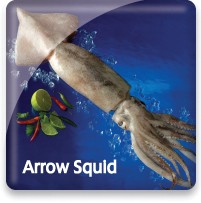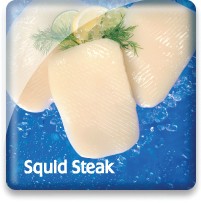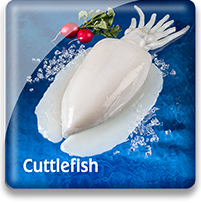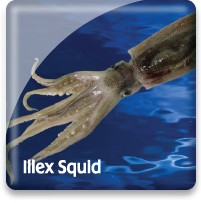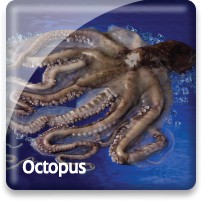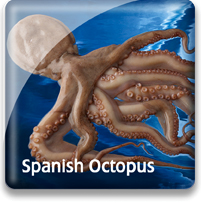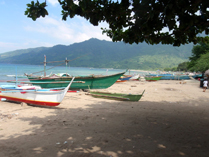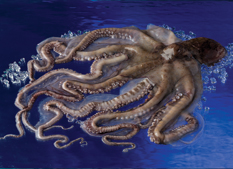
Octopus

Market Name: Eating QualitiesFresh octopus should smell of the ocean. Raw octopus is purplish in color. Cooked, the purple skin conceals a fairly translucent white meat. The flesh is very firm and somewhat chewy, but smooth texture and full ocean flavor, though tender and possesses a mild, almost sweet flavor. All parts of the octopus can be consumed and are either eaten boiled, fried, grilled or stewed.
Octopus have highly developed eyesight and a complex sense of touch and taste. Unlike many other marine species, they have no ability to hear.
|
Description & CharacteristicsOctopus vulgaris is found in tropical, subtropical, and temperate waters between the surface and depths of 100 to 150 meters. Octopus vulgaris can reach lengths of one to eight feet, including arms. The Octopus species replenishes its numbers quite quickly with an average daily growth rate of 3%. A typical lifespan ranges 12 to 18 months. It is also capable of retreating to parts of the sea that will render it more difficult to capture. The common Philippine octopus, Octopus vulgaris, are caught by free-divers by “hand” without the aid of any complicated underwater breathing apparatus, use of traps, or with single hook and line. These methods guarantee that the coral reef where the octopus are caught sustain minimal or no damage. By free-diving for octopus, catching is also limited to depths of 20-30 feet which allow the octopus population to recover from periodic harvests. Octopus vulgaris has been important to commercial fisheries for many generations, and has been a staple to Asian, Hispanic and European menus. Octopus, also called Pulpo, is a cephalopod with eight arms (not tentacles) lined with suction cups. They are found in tropical, subtropical and temperate waters around the world, and can live both in shallow and deep waters. They have almost entirely soft bodies with no internal skeleton. Octopi have built-in defense mechanisms, including the ability to change color in order to avoid detection and the capacity to release an ink cloud to escape potential predators. Highly intelligent, octopi possess sharp eyesight and have an outstanding sense of touch. Their intelligence has been likened to that of a household cat. The life-span of the octopus is short, typically living only one to two years. They travel using a sort of jet propulsion. Although octopi are quite plentiful in the waters along all U.S. coasts, little is eaten. Most of the stock is supplied by frozen imports. Octopus is popular in Mediterranean cuisines, while in the U.S., it is largely limited to ethnic and regional markets.Pulpo is mostly sold head-on and normally cleaned before distribution, this means viscera, eyes and beaks are removed. The ink sac is used in many recipes and may be left with the animal. The skin is edible and therefore remains. Octopus is typically frozen in blocks and graded 1-2, 2-4, 4-6 and 6-8 pounds. Octopus smaller than one pound may be packaged for retail sale. Octopus meat products are also available. Octopus can be tough and is best tenderized by boiling in water prior to preparation. The entire cooking process can last several hours in order to ensure tenderness.
Octopus is an extremely valuable seafood in many parts of the world. It is eaten raw, cooked, dried or smoked.
Other Resources |
Handling Instructions for Octopus
Our whole octopus is sourced from the Philippines, Indonesia, Thailand, Vietnam and Japan is offered in both raw and fully cooked (from Japan) and in sizes ranging from as small as an ounce to more than 13 pounds. Regardless of the origin or size of our whole octopus the proper handling instructions are the same. Our frozen octopus must be stored at or below 0°F (-18°C) and then thawed properly when ready to cook or to eat in the case of our precooked Japanese product. The octopus should be stored in the freezer in the original package or in plastic wrap or a tight fitting plastic bag for product that has been removed from the original packaging. This will help prevent freezer burn (dehydration). Our IQF octopus has an 18 month frozen shelf life and our block frozen has a 24 month frozen shelf life. Links to proper seafood handling instructions: NOAA - Fish Watch: Handling Seafood and A Consumer Guide to Safe Seafood Handling.
Thawing Octopus
Whole octopus can be thawed under refrigeration between 33 and 39°F until it is completely thawed. The thawing time is dependent upon if the octopus is IQF or block frozen. IQF octopus will thaw between 24 and 48 hours depending upon the size of the octopus and block frozen will take up to 48 hours or longer. However, IQF and block frozen octopus can be quickly thawed by placing the product in a colander and running under cold water until thawed. In general, IQF octopus will thaw within several minutes while the block frozen may take 10 to 20 minutes or longer. This is our preferred quick thawing method to use whenever possible.
Important Instructions for Octopus
Thawed raw octopus should be used immediately or within 1-2 days due to the fact that octopus in general has a relatively short thawed shelf life.
Cooking Tips
Whole raw octopus can be challenging to cook to a tender pleasing texture. This is especially true for the larger sizes that can run over 13 pounds. The smaller sized octopuses running less than 1/4th of a pound are less complicated to prepare. However, larger whole octopuses need to be boiled and tested periodically for tenderness during the cooking process. Because of this, our conveniently precooked octopus from Japan is gaining in popularity. Links to cooking tips and recipes: Fish & Seafood Cooking and Recipes
The Philippines
The Republic of the Philippines is actually an archipelago, or group of islands set in the middle of the Pacific Ocean and the South China Sea. Roughly the size of Italy, this island nation boasts more than 10,849 miles. Its fishery is divided into marine, inland, and aquaculture.
Commercial species include scad, tuna (yellowfin and skipjack), mackerel, anchovies, sardines, squid, and blue crab. Aquaculture originally started in the Philippines with the cultivation of “Milkfish” – which took place in brackish water ponds originally, extending later to net cages floating in both fresh water and marine environments.
Shrimp is another major product of the Philippines, starting with Black Tiger prawns, largely exported to Japan. Shrimp underwent a “boom and bust” cycle, because of disease problems that led to a decline in production.
Today, finfish is becoming a popular aquaculture species, particularly Tilapia, some carp; seaweed, oysters and mussels.
Indonesia
The country we refer to as Indonesia is actually an Archipelago of some 17,508 islands and a coastline that encompasses more than 50,000 miles. Within the waters of the Indonesian archipelago, the government has established an “archipelagic country,” retaining exclusive control over these waters. Because of Indonesia’s access to the marine environment, it has vast potential for the development of aquaculture, particularly brackish water shrimp culture. In fact, in an attempt to prevent over-exploitation of the wild fishery resource, the government of Indonesia has established a formal policy to encourage aquaculture development. Mariculture products include various finfish, shellfish, seaweeds, species such as sea cucumber, grouper and seaweed.
Tuna is also an important export product of Indonesia.
|
|
Go Blue! Seafood Sustainability Spectrum*Click here for an explanation of our Sustainability Spectrum 
Sustainability AssessmentTraditional methods of capturing Octopus are usually relatively benign from an environmental standpoint. However, common concerns that exist in many Octopus fisheries are:
Environmental Impact: Moderate to HighLack of information about their ecological role as well as outstanding questions about the connections between local environmental conditions and population health make robust assessments of the Octopus fishery difficult. Many Octopus fisheries also exhibit a serious lack of regulation and/or enforcement.
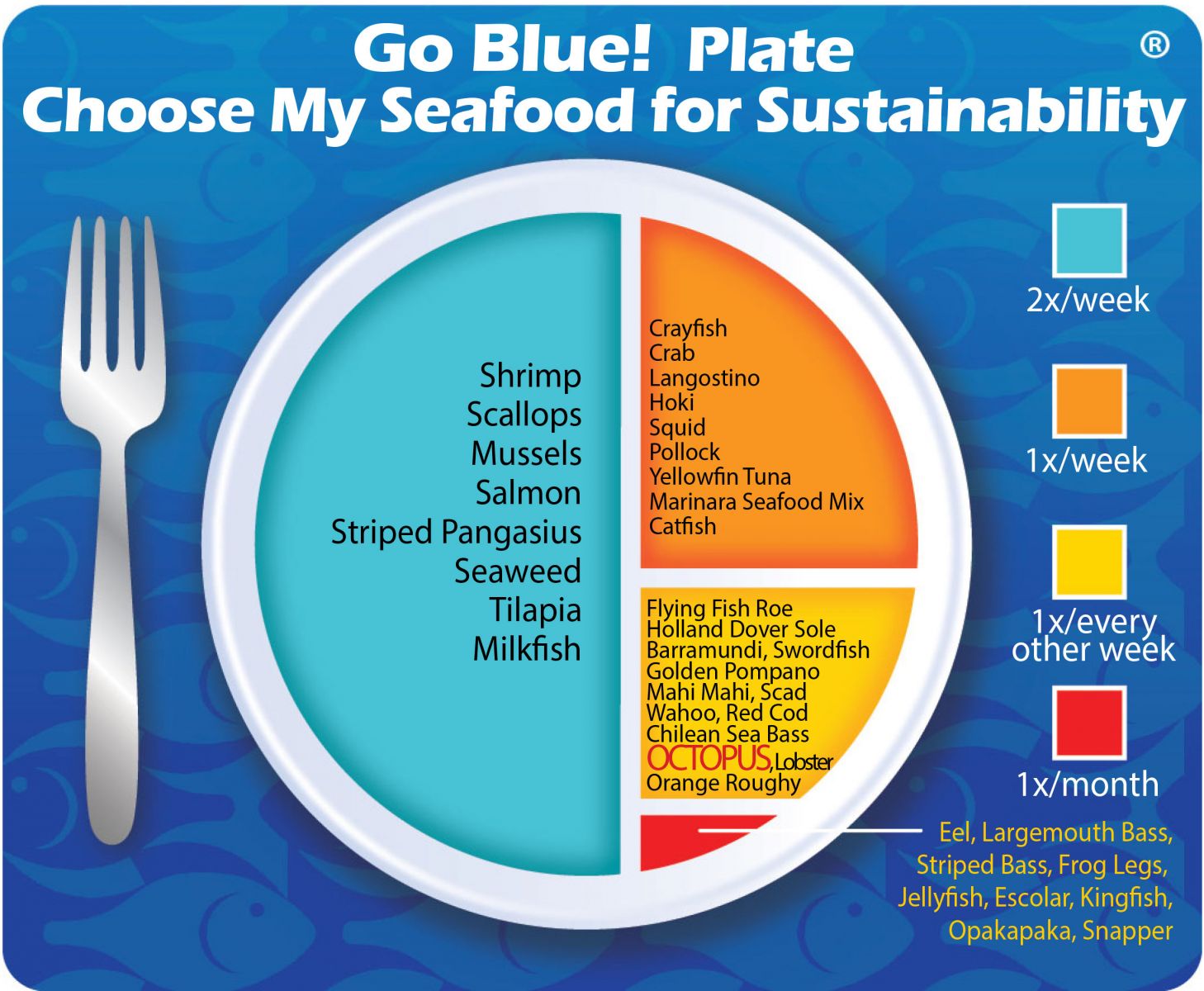
Sustainability Improvements NeededThere is a need for more data and information on Octopus from fisheries (e.g., location, landings, fishing effort, size of octopus being caught) as well as from scientists (e.g., ecological role of Octopus, reproductive strategies). This information can be used to assess the current state of the Octopus resource as well as determining what regulations may be necessary to sustain healthy populations.
Actions that Sea Port is UndertakingSea Port is requiring that their suppliers provide fishing vessel identification (when available), catch methodology, and catch area information. In doing so, Sea Port hopes to encourage the Octopus fisheries to collect additional harvest data which could set the stage for future fishery management improvements. Octopuses are resilient to moderate fishing pressure due to reaching reproductive age quickly and having many offspring. Sea Port sources primarily from artisanal Octopus fisheries and believes that this inherently moderate to low fishing pressure offers a higher degree of protection against overfishing. Sea Port also believes that, in aggregate, choosing from a diverse variety of seafood is better for sustaining the world’s seafood resources and that Octopus should be a part of this variety.
We created the sustainability assessments for each of our seafood items in order to reveal the existing and potential environmental impacts and risks that are associated with producing them for human consumption. This allowed us to establish the starting position for each of our seafood items along our progressive Go Blue! Seafood Sustainability Spectrum®. These assessments are only a single snapshot in time and because of this, we will continue to assess and update the critical sustainability needs associated with our supply sources and issue updates to the Go Blue! Seafood Sustainability Spectrum® as needed. There is a growing global awareness for the need to assure the sustainability of farmed and wild caught seafood and because of this; all around the world positive changes are rapidly occurring at all levels of the seafood supply chain. We will continue to spread this growing awareness and work with our many industry partners to improve the sustainability of all seafood, which we believe is the ideal protein of choice to feed an ever growing world population. Our Go Blue! Seafood Sustainability Spectrum® serves as our compass and yardstick as we strive to move all our products forward to becoming more sustainable. Please join us in this committed quest and Catch Our Wave® to sustainability by choosing a diverse variety of responsibly produced seafood as part of your diet.
|


